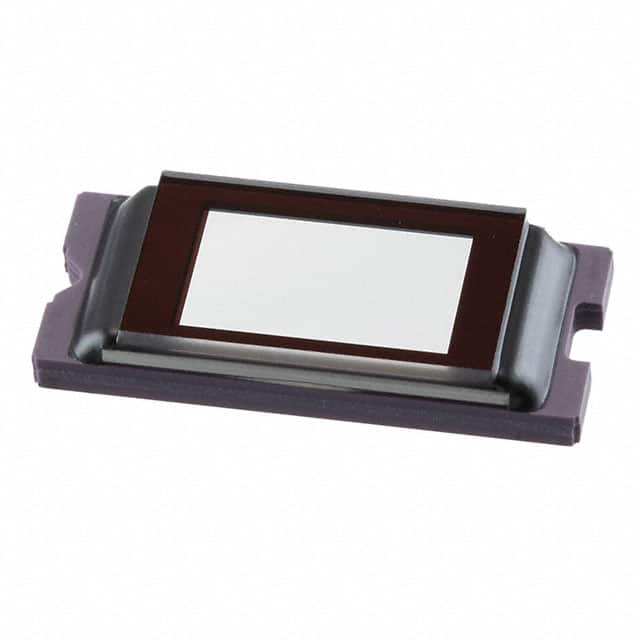Consulte las especificaciones para obtener detalles del producto.

DLP4500NIRFQE
Product Overview
Category
DLP4500NIRFQE belongs to the category of digital micromirror devices (DMDs).
Use
This product is primarily used in applications that require high-speed, high-resolution spatial light modulation. It is commonly employed in fields such as spectroscopy, machine vision, 3D printing, and lithography.
Characteristics
- High-speed operation: The DLP4500NIRFQE offers fast switching speeds, enabling rapid image projection or modulation.
- High resolution: With a native resolution of XGA (1024 x 768 pixels), this device provides detailed and sharp images.
- Near-infrared (NIR) capability: The DLP4500NIRFQE is specifically designed for near-infrared applications, allowing for enhanced performance in this spectral range.
- Compact package: This DMD is housed in a compact package, making it suitable for integration into various systems.
- Essence: The essence of the DLP4500NIRFQE lies in its ability to precisely control the reflection of light, enabling advanced optical manipulation.
Packaging/Quantity
The DLP4500NIRFQE is typically packaged in a small form factor, such as a ceramic package or a chip-scale package. The exact packaging may vary depending on the manufacturer. It is usually available in single-unit quantities for individual use or in bulk quantities for larger-scale applications.
Specifications
- Native resolution: XGA (1024 x 768 pixels)
- Micromirror array size: 0.45-inch diagonal
- Micromirror pitch: 7.6 μm
- Micromirror tilt angle: ±12 degrees
- Spectral range: 700 - 2500 nm
- Fill factor: > 92%
- Frame rate: Up to 5000 Hz
- Power consumption: < 2.5 W
- Operating temperature range: -10 to 60°C
Detailed Pin Configuration
The DLP4500NIRFQE features a specific pin configuration for seamless integration into various systems. The detailed pinout is as follows:
- VCC: Power supply voltage
- GND: Ground reference
- SDA: I2C serial data input
- SCL: I2C serial clock input
- DLPC350RSTN: Reset signal for the digital controller
- DLPC350INTN: Interrupt signal from the digital controller
- DLPC350_SCL: I2C serial clock output
- DLPC350_SDA: I2C serial data output
- DLPA2000_CLK: Clock input for the digital micromirror controller
- DLPA2000_DATA: Data input for the digital micromirror controller
- DLPA2000_VSYNC: Vertical synchronization signal
- DLPA2000_HSYNC: Horizontal synchronization signal
- DLPA2000_DE: Data enable signal
- DLPA2000_BLANK: Blank signal
- DLPA2000_LATCH: Latch signal
- DLPA2000_OE: Output enable signal
- DLPA2000_POL: Polarity control signal
Functional Features
The DLP4500NIRFQE offers several functional features that contribute to its versatility and performance:
- High-speed modulation: This device enables rapid switching of micromirrors, allowing for precise spatial light modulation at high frame rates.
- Digital control: The DLP4500NIRFQE can be easily controlled through an integrated digital micromirror controller, facilitating seamless integration into digital systems.
- Flexible input interface: The device supports standard I2C communication protocols, enabling easy interfacing with microcontrollers or other digital devices.
- High spectral range: With a spectral range of 700 - 2500 nm, the DLP4500NIRFQE is optimized for near-infrared applications, providing enhanced performance in this wavelength region.
- Compact form factor: The small size and lightweight nature of this device make it suitable for integration into space-constrained systems.
Advantages and Disadvantages
Advantages
- High-speed operation enables real-time spatial light modulation.
- High resolution ensures detailed and sharp image projection.
- Near-infrared capability enhances performance in NIR applications.
- Compact package allows for easy integration into various systems.
- Digital control simplifies system integration and operation.
Disadvantages
- Limited spectral range compared to some other DMDs.
- Higher power consumption compared to certain alternative models.
- Relatively higher cost compared to lower-end DMD options.
Working Principles
The DLP4500NIRFQE utilizes an array of micromirrors that can be individually tilted to either reflect or block incident light. By precisely controlling the tilt angle of each micromirror
Enumere 10 preguntas y respuestas comunes relacionadas con la aplicación de DLP4500NIRFQE en soluciones técnicas
Sure! Here are 10 common questions and answers related to the application of DLP4500NIRFQE in technical solutions:
Q: What is the DLP4500NIRFQE? A: The DLP4500NIRFQE is a near-infrared (NIR) digital micromirror device (DMD) developed by Texas Instruments for use in various technical applications.
Q: What are the key features of the DLP4500NIRFQE? A: The key features of the DLP4500NIRFQE include high resolution, fast switching speed, low power consumption, and compatibility with NIR light sources.
Q: How can the DLP4500NIRFQE be used in technical solutions? A: The DLP4500NIRFQE can be used in applications such as spectroscopy, machine vision, 3D scanning, medical imaging, and industrial inspection, among others.
Q: What is the spectral range of the DLP4500NIRFQE? A: The DLP4500NIRFQE operates in the near-infrared range, typically between 700nm and 1100nm.
Q: Can the DLP4500NIRFQE be integrated with other components or systems? A: Yes, the DLP4500NIRFQE can be easily integrated with other optical components, light sources, cameras, and control electronics to create complete technical solutions.
Q: What is the resolution of the DLP4500NIRFQE? A: The DLP4500NIRFQE has a native resolution of 912 x 1140 micromirrors, which can be used to achieve high-quality imaging and projection.
Q: How fast is the switching speed of the DLP4500NIRFQE? A: The DLP4500NIRFQE has a fast switching speed of up to 20,000 frames per second, enabling rapid image or pattern projection.
Q: Does the DLP4500NIRFQE require any special cooling or power requirements? A: The DLP4500NIRFQE operates at low power and does not require any special cooling mechanisms, making it easy to integrate into various technical solutions.
Q: Can the DLP4500NIRFQE be controlled remotely? A: Yes, the DLP4500NIRFQE can be controlled remotely using standard interfaces such as HDMI, USB, or Ethernet, allowing for convenient operation and integration.
Q: Are there any development resources available for the DLP4500NIRFQE? A: Yes, Texas Instruments provides comprehensive documentation, software development kits (SDKs), and support resources to assist developers in utilizing the DLP4500NIRFQE in their technical solutions.
Please note that these questions and answers are general and may vary depending on specific use cases and requirements.

